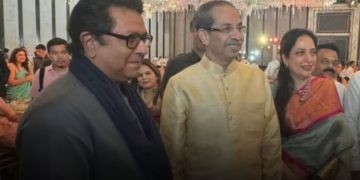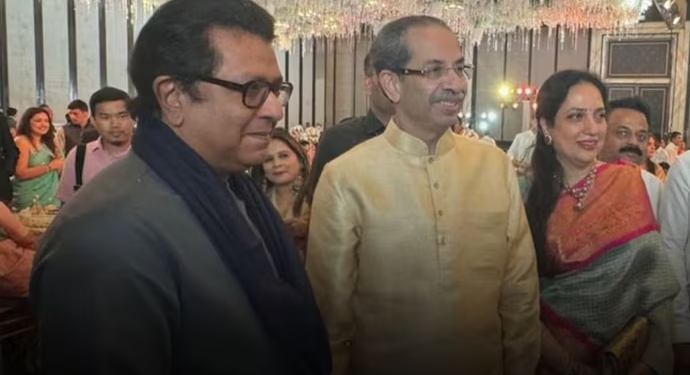Uddhav and Raj Thackeray to share stage in Mumbai for the first time in two decades at the Marathi Vijay Melava on July 5. A historic political reunion not to miss!

A Historic Reunion After Two Decades
Uddhav Thackeray, former Maharashtra Chief Minister and leader of Shiv Sena (UBT), and his cousin Raj Thackeray, president of Maharashtra Navnirman Sena (MNS),
are set to share the stage after nearly 20 years of political estrangement. This reunion, driven by a united stand against the imposition of Hindi in Maharashtra’s schools, marks a significant pivot in regional politics.
The backdrop to this alliance is the contentious three‑language policy proposed by the Maharashtra government, which mandated Hindi from Class 1 in all state schools. Both Thackerays rallied together, terming this move an attempt at Hindi imposition, threatening regional identity and the primacy of Marathi. Initially planning separate marches — Uddhav on July 7 and Raj on July 6 — their parties merged efforts, rescheduling a joint victory rally for July 5 at the iconic Shivaji Park in Dadar, Mumbai.
🗓 Event Overview: Marathi Vijay Melava – July 5, Shivaji Park
What’s Happening?
- The “Marathi Vijay Melava” is a celebratory march-cum-rally to mark the rollback of the contentious government resolutions (GRs) on Hindi language imposition. It transforms a planned protest into a “victory procession”.
- Rather than a divisive demonstration, the initiative aims to celebrate Marathi identity, projecting solidarity across party lines.
Why Shivaji Park?
- Shivaji Park, where Balasaheb Thackeray launched his early rallies, remains the spiritual heart of Shiv Sena politics. Holding the rally here signals a symbolic full circle — a return to the roots of Marathi mobilization.
Key Players:
- Uddhav Thackeray emphasized the rally as protection against attempts to “divide Marathi manoos”, blaming the BJP for seeking to drive wedges into the regional community.
- Raj Thackeray declared the protest could become “so massive it would remind people of the Samyukta Maharashtra movement,” denouncing lack of transparency in the language policy .
- Sanjay Raut, Sena leader, hailed the policy reversal as a triumph of Marathi unity and credited the Thackerays’ combined influence.
🧭 Political Ripple Effects
1. End of a Rivalry?
Their coming together ends a long-standing feud that started when Raj left Shiv Sena in 2005, founding MNS in 2006 after disagreements over party leadership. While the reunion might be event-specific, it revives speculation of deeper reconciliation.
2. Broader Alliances and Repercussions
- Sharad Pawar, NCP leader, threw his support behind the Thackerays, backing their argument for optional Hindi instruction until after Class 5.
- With unification on such a charged issue, Maharashtra’s political landscape could see reshuffled alliances, particularly impacting the BJP-led state government which faced accusations of forcing language policy shifts.
3. Cultural Sovereignty and Regional Pride
This movement doesn’t merely challenge policy—it symbolizes regional identity. It taps into a larger movement ensuring that Marathi language, heritage, and culture retain central importance in local education and governance.
🎥 In Their Own Words
A YouTube video titled “Uddhav & Raj Thackeray Reunite After 20 Years! The Truth Behind Their Shock Hindi Protest” discusses the depth and context of this rare collaboration timesofindia.indiatimes.com+5youtube.com+5youtube.com+5:
This clip highlights both leaders presenting a united front—setting aside decades of rivalry to take on what they view as a broader threat to Marathi identity.
📝 On-the-Ground Implications
- Public Mobilisation
The July 5 Melava is expected to draw large crowds from across Maharashtra, mobilized by pride in regional identity. Its reach could extend beyond urban centers if mirrored in other districts. - Media & Political Discourse
The Thackerays’ joint intervention is likely to drive media debate on:- The pros and cons of multilingual education policies.
- The Centre and state’s roles in imposing or promoting Hindi.
- Impact on regional languages in a centralizing policy environment.
- Future of Thackeray Unity
While this event addresses a specific issue, it may lay groundwork for enduring cooperation between Shiv Sena (UBT) and MNS—potentially shifting voter alignments in upcoming elections.
🔍 Key Takeaways
| Aspect | Insight |
|---|---|
| Symbolism | Two cousins, once political rivals, now united against a common cause. |
| Issue | The Hindi imposition debate touches on education, identity, and linguistic equity. |
| Event | From a protest march to a victory rally, staged at the symbolic Shivaji Park. |
| Impact | Could realign politics in Maharashtra, strengthen regional solidarity, and set precedents for language policy discussions. |
🧭 Looking Ahead
The “Marathi Vijay Melava” isn’t just a one-day event—it may mark a turning point. Should the Thackerays maintain this unity, they could command a powerful marsoon‑centric political coalition, challenging both the BJP and other non-regional parties. The rally’s tone, crowd, and aftermath will indicate whether this reconciliation is momentary or the start of sustained collaboration.
Table of Contents
Final Word
On July 5, 2025, history may repeat itself—but with a twist. Shivaji Park, once the crucible of Balasaheb Thackeray’s politics, becomes the stage for his successors’ rare reunion. As they raise the banner of Marathi pride, the broader message is clear: unity against linguistic imposition—and for regional identity—is the new rallying cry. Whether this alliance deepens beyond the Hindi row remains to be seen—but for now, the morcha is a moment of triumph for Maharashtra’s photograph.
READ ALSO……Uddhav Thackeray Unity Against Hindi Imposition: Uddhav & Raj to Lead Joint Mumbai Protest 2025















 Categories
Categories









